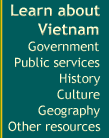Vietnam is a multi-nationality country with 54 ethnic groups. The
Viet (Kinh) people account for 87% of the country’s
population
and mainly inhabit the Red River delta, the central coastal delta, the
Mekong delta and major cities. The other 53 ethnic minority
groups, totalling over 8 million people, are scattered over mountain
areas (covering two-thirds of the country’s territory) spreading from
the North to the South.
Among ethnic minorities, the most populated are Tay, Thai,
Muong, Hoa, Khmer, Nung... with a population of around 1
million each, while the least populated are Brau, Roman, Odu with
several hundred people each.
The Viet people succeeded in establishing a centralized monarchy
right in the 10th century. The Cham people once boasted a
flourishing culture early in the history. The Tay, Nung, and Khmer
peoples had reached high levels of development with the presence
of various social strata. The Muong, H’mong, Dao, Thai
peoples... gathered under the rule of local tribal heads. Many ethnic
groups divided their population into social echelons, especially those
who lived in mountainous areas.
A number of ethnic minorities had mastered some farming
techniques. They grew rice plants in swamped paddy fields and
carried out irrigation. Others went hunting, fishing, collecting and
lived a semi-nomadic life. Each group has its own culture, diverse
and special. Beliefs and religions of the Vietnamese ethnic minority
groups were also disparate from each other.
However, a fundamental solidarity among ethnic groups has been
established on top of this difference as a result of a centuries long
cooperation on the soil of Vietnam. Right in the first century of the
history, a mutual supplement in economic relationship between
lowland people and mountainous people was formed. This solidarity
had been unceasingly strengthened during wars of resistance for
defending the country. Through the shared struggle for defending
and building of the country and the mutual assistance for
co-existence and development, a common community between the
Viet people and other ethnic minority peoples had been established
and continuously consolidated and developed.
Nonetheless, an evident gap in the material and moral life has
indeed still existed between peoples living in the deltas and those
living in mountain areas as well as among ethnic minorities
themselves. The Vietnamese government has worked out specific
policies and special treatments in order to help mountainous people
catching up with lowland people, and made great efforts to develop
and preserve traditional cultural identities of each ethnic minority
group. At present, the programs of providing iodized salt for remote
villages, equipping village’s health care and hygienic station,
fighting
malaria, building free schools for ethnic minority children, settled
agriculture and fixed residence, and projects of creating new writing
scripts for minority peoples and studying and developing traditional
culture of each ethnic minority group... have obtained sactifactory
results.
Table of all ethnic groups











